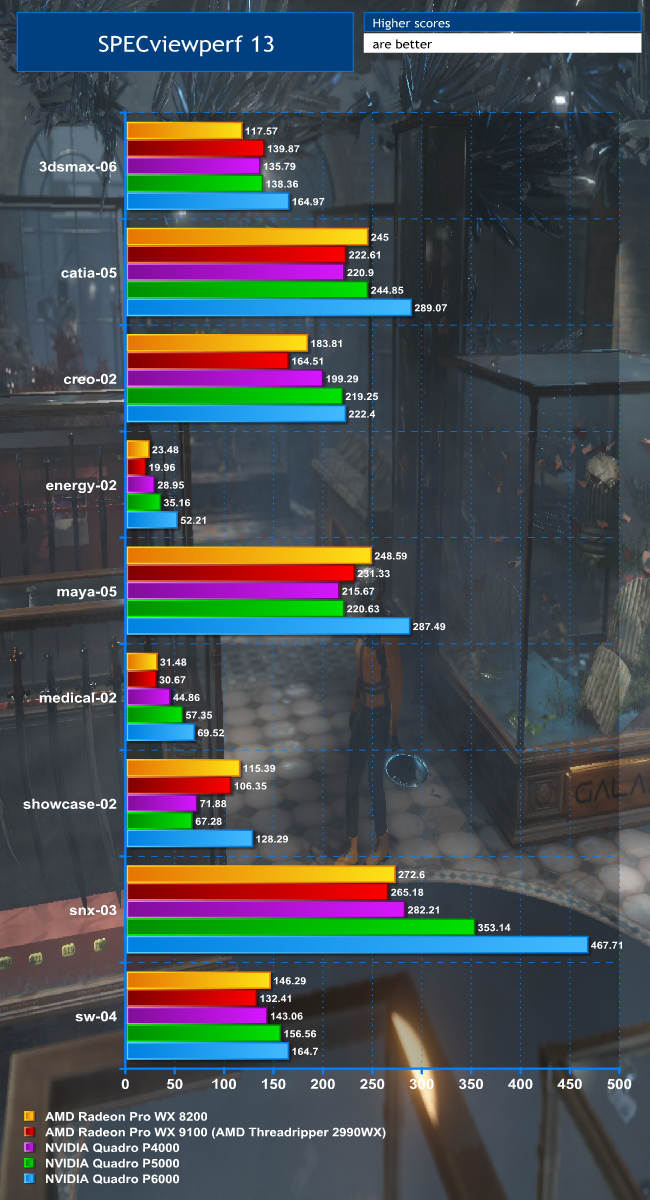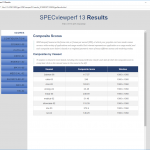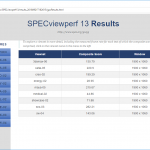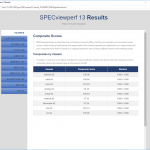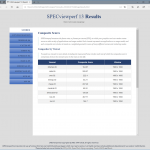SPECviewperf 13
The SPECviewperf 13 benchmark is the worldwide standard for measuring graphics performance based on professional applications. The benchmark measures the 3D graphics performance of systems running under the OpenGL and Direct X application programming interfaces. The benchmark’s workloads, called viewsets, represent graphics content and behavior from actual applications.
The latest version is SPECviewperf 13, released on May 23, 2018. SPECgpc members at the time of V13 release include AMD, Dell, Fujitsu, HP, Intel, Lenovo, and NVIDIA.
SPECviewperf 13 is a comprehensive upgrade of previous versions of the benchmark. Medical and energy viewsets incorporate new models and raycasting for volume visualization; the Maya viewset features new models based on the SPECapc for Maya 2017 benchmark; and the Creo viewset has been updated with fresh application traces. All other viewsets have been recompiled with minor changes. Results from SPECviewperf 13 are not comparable to those from earlier versions.
Other major updates in SPECviewperf 13 include:
- Support for 4K resolution displays.
- New reporting methods, including JSON output that enables more robust and flexible result parsing.
- A new user interface that will be standardized across all SPEC/GWPG benchmarks.
- New workloads and scoring that reflect the range of activities found in real-world applications.
- Various bug fixes and performance improvements.
The results with SPECviewperf 13 are much more varied, showing how much professional graphics choice is considerably affected by precisely what software you intend to run. Note that in these tests the AMD Radeon Pro WX 9100 was tested on a slightly different platform, which may have affected the results in some viewsets, so these scores are included merely for comparison.
The WX 8200 performs very respectably with the 3dsmax-06 viewset, beating the WX 9100 and NVIDIA Quadros up to and including the P5000, although the mega-expensive P6000 is way ahead of the pack. This will be a great graphics card for modelling with Autodesk 3ds Max.
The story is similar with the catia-05 viewset. The WX 8200 just squeezes past the P4000, although the P5000 is significantly in front, and the P6000 is again way ahead. If your main work is with Dassault Systèmes CATIA, the WX 8200 will be a cost-effective option.
The WX 8200 is not so impressive with the creo-02 viewset, coming in last amongst the other cards. The Quadro P4000 is 21 per cent faster, making it the better option if you run the PTC Creo CAD software mainly.
The story is similar with the energy-02 and medical-02 viewsets. However, these tests don't correspond directly to specific branded software applications. The energy-02 viewset is based OpendTect seismic visualisation.
With the maya-05 viewset, the WX 8200 can't beat its premium WX 9100 sibling, but it cruises past the P4000 and P5000. The P6000 is (as usual) noticeably out in front. If you do 3D animation with Autodesk Maya, as with 3ds Max, the WX 8200 will provide very smooth modelling for the money.
The showcase-02 viewset is another one based on Autodesk software, in this case Showcase. AMD Radeon Pros are clearly well optimised for this. The WX 9100 is only 11 per cent slower than the Quadro P6000, and the WX 8200 only 9 per cent slower than the WX 9100. The P4000 and P5000 are left in the dust.
The final two viewsets – snx-03 and sw-04 – are focused on CAD software used frequently for product design – Siemens NX and Solidworks respectively. The WX 8200 is respectable in both tests, but behind the other cards. If you use either of these applications, NVIDIA's Quadro P4000 is a slightly better sub-£1,000 graphics card choice.
Overall, though, the AMD Radeon Pro WX 8200 acquits itself very well with SPECviewperf 13, considering that it is the cheapest card on test. Its forte appears to be 3D animation with Autodesk applications rather than engineering or product design CAD, but even with these types of software it does respectably, if slightly behind the NVIDIA competition.
 KitGuru KitGuru.net – Tech News | Hardware News | Hardware Reviews | IOS | Mobile | Gaming | Graphics Cards
KitGuru KitGuru.net – Tech News | Hardware News | Hardware Reviews | IOS | Mobile | Gaming | Graphics Cards


